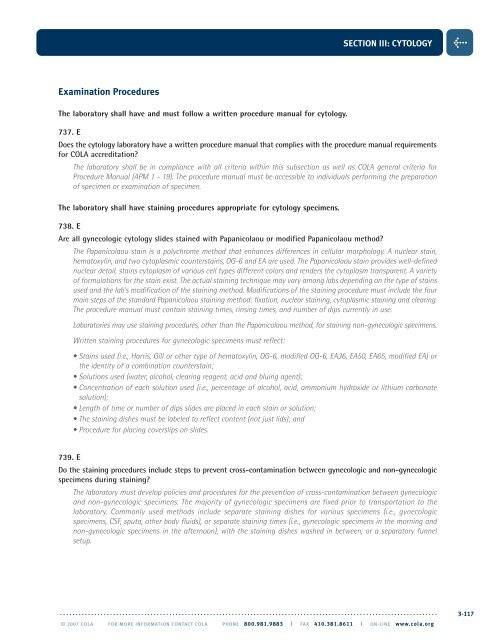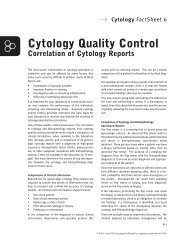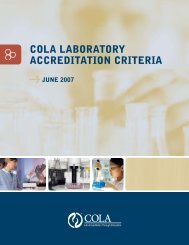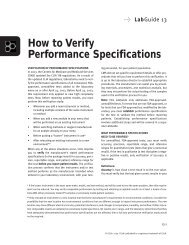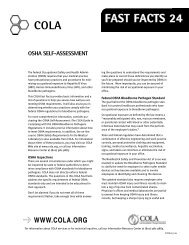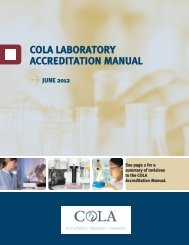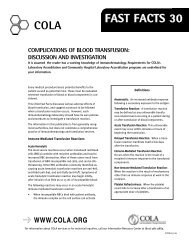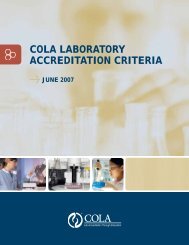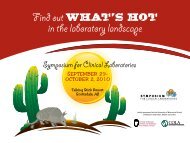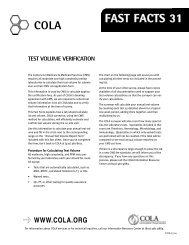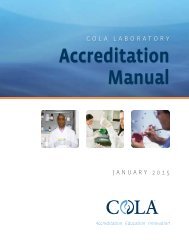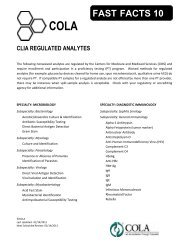Download - COLA
Download - COLA
Download - COLA
- No tags were found...
Create successful ePaper yourself
Turn your PDF publications into a flip-book with our unique Google optimized e-Paper software.
SECTION III: CYTOLOGY>Examination ProceduresThe laboratory shall have and must follow a written procedure manual for cytology.737. EDoes the cytology laboratory have a written procedure manual that complies with the procedure manual requirementsfor <strong>COLA</strong> accreditation?The laboratory shall be in compliance with all criteria within this subsection as well as <strong>COLA</strong> general criteria forProcedure Manual (APM 1 - 19). The procedure manual must be accessible to individuals performing the preparationof specimen or examination of specimen.The laboratory shall have staining procedures appropriate for cytology specimens.738. EAre all gynecologic cytology slides stained with Papanicolaou or modified Papanicolaou method?The Papanicolaou stain is a polychrome method that enhances differences in cellular morphology. A nuclear stain,hematoxylin, and two cytoplasmic counterstains, OG-6 and EA are used. The Papanicolaou stain provides well-definednuclear detail, stains cytoplasm of various cell types different colors and renders the cytoplasm transparent. A varietyof formulations for the stain exist. The actual staining technique may vary among labs depending on the type of stainsused and the lab’s modification of the staining method. Modifications of the staining procedure must include the fourmain steps of the standard Papanicolaou staining method: fixation, nuclear staining, cytoplasmic staining and clearing.The procedure manual must contain staining times, rinsing times, and number of dips currently in use.Laboratories may use staining procedures, other than the Papanicolaou method, for staining non-gynecologic specimens.Written staining procedures for gynecologic specimens must reflect:• Stains used (i.e., Harris, Gill or other type of hematoxylin, OG-6, modified OG-6, EA36, EA50, EA65, modified EA) orthe identity of a combination counterstain;• Solutions used (water, alcohol, clearing reagent, acid and bluing agent);• Concentration of each solution used (i.e., percentage of alcohol, acid, ammonium hydroxide or lithium carbonatesolution);• Length of time or number of dips slides are placed in each stain or solution;• The staining dishes must be labeled to reflect content (not just lids); and• Procedure for placing coverslips on slides.739. EDo the staining procedures include steps to prevent cross-contamination between gynecologic and non-gynecologicspecimens during staining?The laboratory must develop policies and procedures for the prevention of cross-contamination between gynecologicand non-gynecologic specimens. The majority of gynecologic specimens are fixed prior to transportation to thelaboratory. Commonly used methods include separate staining dishes for various specimens (i.e., gynecologicspecimens, CSF, sputa, other body fluids), or separate staining times (i.e., gynecologic specimens in the morning andnon-gynecologic specimens in the afternoon), with the staining dishes washed in between, or a separatory funnelsetup.. . . . . . . . . . . . . . . . . . . . . . . . . . . . . . . . . . . . . . . . . . . . . . . . . . . . . . . . . . . . . . . . . . . . . . . . . . . . . . . . . . . . . . . . . . . . . . . . . . . . . . . . . . . . . . . . . . . . . . . . .© 2007 <strong>COLA</strong> FOR MORE INFORMATION CONTACT <strong>COLA</strong> PHONE 800.981.9883 | FAX 410.381.8611 | ON-LINE www.cola.org3-117


